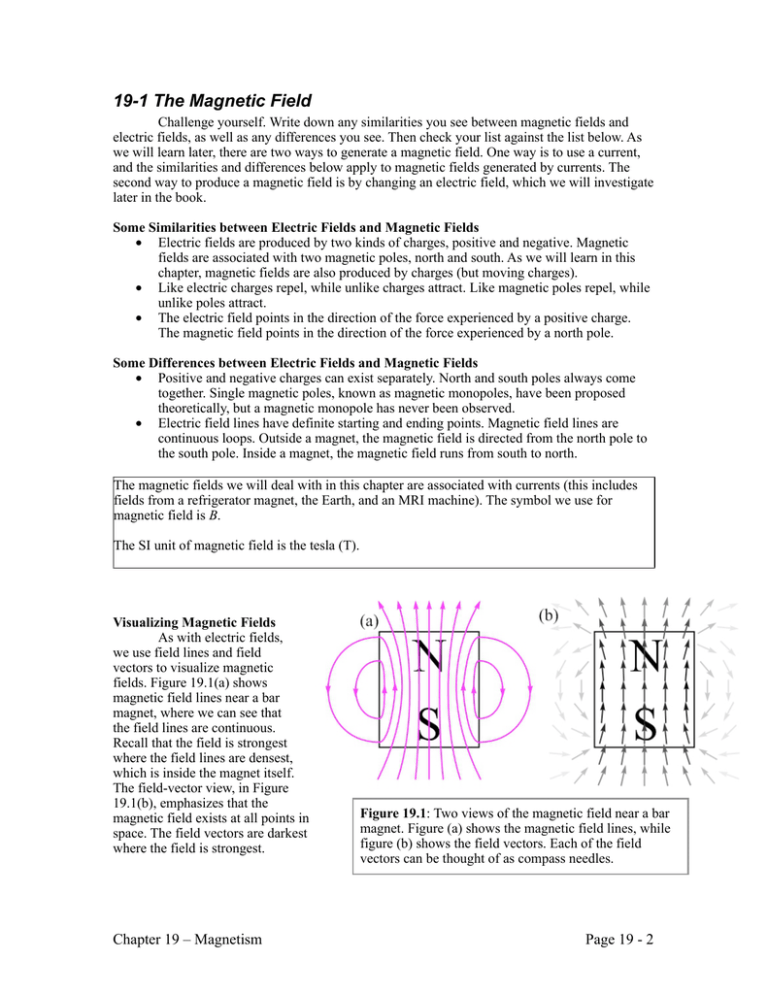19-1 The Magnetic Field
advertisement

19-1 The Magnetic Field Challenge yourself. Write down any similarities you see between magnetic fields and electric fields, as well as any differences you see. Then check your list against the list below. As we will learn later, there are two ways to generate a magnetic field. One way is to use a current, and the similarities and differences below apply to magnetic fields generated by currents. The second way to produce a magnetic field is by changing an electric field, which we will investigate later in the book. Some Similarities between Electric Fields and Magnetic Fields • Electric fields are produced by two kinds of charges, positive and negative. Magnetic fields are associated with two magnetic poles, north and south. As we will learn in this chapter, magnetic fields are also produced by charges (but moving charges). • Like electric charges repel, while unlike charges attract. Like magnetic poles repel, while unlike poles attract. • The electric field points in the direction of the force experienced by a positive charge. The magnetic field points in the direction of the force experienced by a north pole. Some Differences between Electric Fields and Magnetic Fields • Positive and negative charges can exist separately. North and south poles always come together. Single magnetic poles, known as magnetic monopoles, have been proposed theoretically, but a magnetic monopole has never been observed. • Electric field lines have definite starting and ending points. Magnetic field lines are continuous loops. Outside a magnet, the magnetic field is directed from the north pole to the south pole. Inside a magnet, the magnetic field runs from south to north. The magnetic fields we will deal with in this chapter are associated with currents (this includes fields from a refrigerator magnet, the Earth, and an MRI machine). The symbol we use for magnetic field is B. The SI unit of magnetic field is the tesla (T). Visualizing Magnetic Fields As with electric fields, we use field lines and field vectors to visualize magnetic fields. Figure 19.1(a) shows magnetic field lines near a bar magnet, where we can see that the field lines are continuous. Recall that the field is strongest where the field lines are densest, which is inside the magnet itself. The field-vector view, in Figure 19.1(b), emphasizes that the magnetic field exists at all points in space. The field vectors are darkest where the field is strongest. Chapter 19 – Magnetism Figure 19.1: Two views of the magnetic field near a bar magnet. Figure (a) shows the magnetic field lines, while figure (b) shows the field vectors. Each of the field vectors can be thought of as compass needles. Page 19 - 2 The Magnetic Field of the Earth The Earth’s magnetic field is weak compared to a magnet on your refrigerator, but the Earth’s field is strong enough to be used by humans, birds, and bacteria for navigation, and to act as a protective shield for the Earth. The Earth’s field has a strength of about at the surface of the Earth, depending on the location. Presently, the Earth’s field is gradually decreasing in strength. For comparison, a typical refrigerator magnet has a magnetic field in the millitesla range, while a strong magnet in a research lab has a field of about 10 T. At the surface of the Earth, the magnetic field is stronger near the poles, where the field lines are vertical, and weaker near the equator, where the field lines are horizontal. The Earth’s field is similar in form to that from a bar magnet, and thus resembles the field in Figure 19.1. However, the Earth’s magnetic field is not nearly as symmetric as the field from a bar magnet. As shown in Figure 19.2, the form of the Earth’s magnetic field is strongly influenced by the solar wind, which consists of charged particles that are emitted by the Sun. Fortunately for us, the Earth’s field protects us from much of the effects of the solar wind. What produces the Earth’s magnetic field? This question is one that scientists are working to answer completely, but the basic mechanism is that is associated with electric charge carried by swirling flows of molten iron deep within the Earth’s core. The location of the Earth’s magnetic poles changes over time, as the currents within the Earth change. Mostly, the magnetic poles wander around gradually, but roughly every 250 000 years or so, on average, the Earth’s magnetic field flips direction (taking a couple of thousand years to flip). The last flip was about 780 000 years ago, so we are overdue for a change. A reversal of the Earth’s field direction requires a major change in the flow patterns of the molten iron within the Earth. Understanding such major changes is an area of cuttingedge research. Figure 19.2: In this illustration, the Sun is shown at the left. The solar wind, which streams outward from the Sun, causes the Earth’s magnetic field (at the right) to be highly asymmetric, with the field lines extending a significant distance to the right, beyond the extent of this illustration. The Earth’s field acts as a rather effective shield against the energetic charged particles in the solar wind. Illustration from SOHO (ESA & NASA). Related End-of-Chapter Exercises: 10, 33, 36. Essential Question 19.1: If the north pole of a compass needle points toward the south pole of a magnet, why does the north pole of a compass point north on the Earth? Chapter 19 – Magnetism Page 19 - 3


